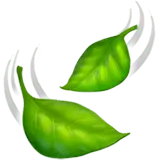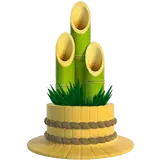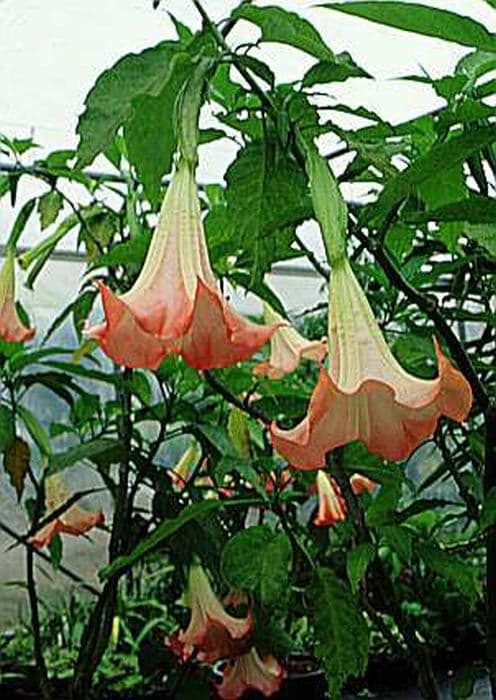Mandrake Mandragora officinarum






ABOUT
The Mandrake, commonly known as Mandragora officinarum, is a perennial plant that has an intriguing and quite mythical presence. Its appearance is characterized by its large, dark green leaves that grow close to the ground in a rosette formation. These leaves are often broad, and may have a wrinkly or wavy texture, giving the plant a lush, full look. One of the most distinctive features of the Mandrake is its roots. The root system is large and often resembles a human figure, which has been the subject of many superstitions and legends. In color, the roots generally range from a tan to dark brown. This human-like shape has captured the imagination for centuries, contributing to the plant's mystical reputation. As for its flowers, the Mandrake produces bell-shaped blooms that can be a striking blue-violet color, though in some cases, they may also be greenish or white. These flowers typically emerge in the space between the leaves, adding a splash of color close to the ground level. Following the flowering stage, the Mandrake bears fruit. The fruit of the Mandrake is a berry that starts out green and ripens to a yellow or orange color. These berries are reminiscent of small tomatoes in appearance, and while they are attractive, they carry the plant's toxic properties, making them dangerous for consumption. Overall, the Mandrake's visual characteristics – from its broad leaves and human-shaped roots to its colorful flowers and fruit – contribute to a unique and somewhat mysterious profile that has captured human fascination across cultures and ages.
About this plant
 Names
NamesFamily
Solanaceae.
Synonyms
Mandrake, European Mandrake, Satan's Apple, Womandrake, Sorcerer's Root, Hermione, Main-de-Gloire, Mandragor, Mandragora.
Common names
Mandragora vernalis, Mandragora autumnalis, Mandragora microcarpa, Mandragora turcomanica, Mandragora officinarum var. vernalis.
 Toxicity
ToxicityTo humans
Mandrake (Mandragora officinarum) is a highly toxic plant when ingested by humans. All parts of the mandrake contain tropane alkaloids, such as scopolamine, hyoscyamine, and atropine, which can cause a range of symptoms if ingested. These symptoms can include dry mouth, difficulty swallowing, dilated pupils, blurred vision, increased heart rate, hallucinations, delirium, and in severe cases, coma or death. Physical contact with the plant can also cause skin irritation. Accidental poisoning typically occurs either from confusion with edible plants or from intentional ingestion for mandrake's historical use as a sedative or for its hallucinogenic properties.
To pets
Mandrake is also toxic to pets. If an animal ingests any part of the mandrake plant, they can exhibit signs of toxicity similar to those in humans due to the presence of tropane alkaloids. Symptoms might include vomiting, diarrhea, severe gastrointestinal upset, incoordination, increased heart rate, difficulty breathing, dilated pupils, and in extreme cases, seizures or death. It is important to prevent pets from accessing this plant due to its high toxicity.
 Characteristics
CharacteristicsLife cycle
Perennials
Foliage type
Evergreen
Color of leaves
Green
Flower color
Blue
Height
1-2 feet (30-60 cm)
Spread
1-2 feet (30-60 cm)
Plant type
Herb
Hardiness zones
7
Native area
Mediterranean
Benefits
 General Benefits
General Benefits- Ancient folklore interest: Mandrake has a rich history in folklore and mythology, providing cultural and educational interest.
- Ornamental value: With its distinctive foliage and sometimes flowers, mandrake can be an interesting addition to themed gardens.
- Historic cultivation: Mandrake has been cultivated since ancient times, offering historical horticultural significance.
- Wildlife habitat: Mandrake can provide a natural habitat for certain insects and small animals when grown in an outdoor setting.
- Education and research: Mandrake is used in educational settings for the study of ethnobotany and plant pharmacology.
- Cultural ceremonies: In some cultures, mandrake is used in traditional ceremonies, contributing to cultural heritage.
 Medical Properties
Medical Properties- Anesthetic: Mandragora officinarum has been used historically as an anesthetic due to its high content of tropane alkaloids.
- Analgesic: The plant's extract was traditionally applied to relieve pain.
- Sedative: Due to its calming effects, it was used to induce sleep and manage insomnia.
- Antispasmodic: The plant's components might have been used to treat cramps and spasms.
- Hallucinogenic: The tropane alkaloids in mandrake can induce hallucinations and have been used in some cultures for their psychoactive effects.
 Air-purifying Qualities
Air-purifying QualitiesThis plant is not specifically known for air purifying qualities.
 Other Uses
Other Uses- Mythical Charm: The mandrake has long been used in folklore and rituals as an amulet to bring luck and ward off evil spirits due to its human-like root structure.
- Agricultural Use: Farmers in past ages sometimes planted mandrake around their fields hoping that its strong associations with fertility would transfer to their crops.
- Ink Production: Historically, the dark juice derived from the berries of the mandrake has been used as a form of ink for writing.
- Love Philtres: The mandrake root, because of its resemblance to the human form, was often used in potions to supposedly attract or intensify love.
- Curio Collections: Due to its rarity and unique appearance, dried mandrake roots are sometimes collected by enthusiasts of the occult or curious botanists.
- Dye Source: The mandrake plant has been employed superficially to create a yellow to brown dye for textiles.
- Folk Craft: Pieces of mandrake root are sometimes carved into figurines or talismans, a practice stretching back to ancient times.
- Literary Symbol: The mandrake has been used symbolically in literature to represent themes of love, fertility, and death across various cultures.
- Theatrical Effects: In theater productions, especially those set in medieval or magical contexts, representations of mandrake roots may be used to enhance the authenticity of the setting.
- Dolls and Figurines: Analogous to its use in folk craft, the root has been shaped to resemble human figures, serving as a primitive form of a doll for entertainment or ritualistic purposes.
Interesting Facts
 Feng Shui
Feng ShuiThe mandrake is not used in Feng Shui practice.
 Zodiac Sign Compitability
Zodiac Sign CompitabilityThe mandrake is not used in astrology practice.
 Plant Symbolism
Plant Symbolism- Magic and Sorcery: Mandrake, often associated with ancient witchcraft, alchemy, and magical practices, was believed to have supernatural powers due to its human-like root.
- Fertility: Due to its root's resemblance to the human body, mandrake has been symbolically used in rituals and potions to enhance fertility and virility.
- Protection: The mandrake has been carried as an amulet or placed in homes to ward off evil spirits and ensure protection against harm.
- Love: Folklore suggests that mandrake was used in love spells or as an aphrodisiac to attract or maintain a romantic or sexual partner.
- Health and Healing: Medicinally, mandrake has been used historically to numb pain due to its anesthetic properties, thereby symbolizing healing.
- Wealth: The rarity and unique qualities of mandrake made it a valuable plant, often associated with wealth and prosperity.
 Water
WaterThe Mandrake requires watering when the topsoil feels dry to the touch; this could mean watering approximately once a week, but it's vital to adjust based on the plant's environment and the season. Make sure to water deeply, allowing water to seep through to the root level; using around 2 cups (16 ounces) for a small to medium-sized pot is typically sufficient. During the winter months, reduce the frequency of watering as the plant enters a dormant phase. It's crucial not to overwater the Mandrake, as it is susceptible to root rot, so ensure proper drainage in the pot.
 Light
LightMandrakes, or Mandrake plants, perform best in partial shade and require protection from the intense afternoon sun. An ideal spot would be one where the plant can enjoy morning sunlight and then be shaded during the hottest part of the day. Dappled sunlight, like that found under a canopy of trees, is optimal for encouraging healthy growth without causing sunburn to the leaves.
 Temperature
TemperatureMandrakes prefer temperate climates and can endure temperatures ranging from as low as 25°F during their dormant winter phase up to around 85°F in the growing season. However, the ideal temperature for a Mandrake is between 50°F and 70°F. Extended exposure to temperatures outside of these ranges, particularly frost or extreme heat, could harm the plant.
 Pruning
PruningMandrakes do not typically require regular pruning. Pruning may be necessary to remove dead or damaged foliage, which can be done as needed at any time of the year. It's essential to use clean, sharp shears to make clean cuts that will heal quickly, reducing the risk of disease. After flowering and fruiting, if the plant looks untidy, you can lightly prune to maintain its shape and encourage new growth for the next season.
 Cleaning
CleaningAs needed
 Soil
SoilMandrake (Mandragora officinarum) prefers a well-draining soil mix with a pH around 6.0 to 7.0. A mix of sand, peat, and loam is ideal to mimic its natural growing conditions.
 Repotting
RepottingMandrakes should be repotted every 2-3 years to refresh the soil and accommodate root growth. Handle carefully to avoid damaging the taproot.
 Humidity & Misting
Humidity & MistingMandrake plants thrive best with moderate humidity levels, avoiding extremes of too dry or too humid conditions.
 Suitable locations
Suitable locationsIndoor
Place mandrake in bright, indirect light with good airflow.
Outdoor
Grow mandrake in partial shade, sheltered from strong winds.
Hardiness zone
6-11 USDA
 Life cycle
Life cycleMandrake (Mandragora officinarum) begins its life cycle as a seed, typically sown in the fall, and germinates to produce small rosettes of leaves. As the plant matures, it develops a large, branched taproot that stores nutrients and energy. During spring, the mandrake produces a stem with a whorl of leaves and bell-shaped flowers, which can range in color from blue-violet to greenish-white. Following pollination, these flowers develop into yellow or orange berries containing seeds that are dispersed by animals. The plant is perennial and will enter a dormant stage during the hot summer months, retreating back to its large root until conditions become favorable again. It continues this cycle, growing larger and more robust each year, for many years.
 Propogation
PropogationPropogation time
Spring to Summer
The most popular method of propagating Mandrake, scientifically known as Mandragora officinarum, is through seed sowing. This is typically done in late summer to early fall, aligning with the plant's natural germination period. After collecting the ripe berries from the mother plant, the seeds are extracted and cleaned. They need to be sown immediately as their viability decreases rapidly with time. Seeds should be placed in a well-draining soil mix, covering them lightly with about 1/4 inch (about 6 millimeters) of soil. The pots are then kept at cool temperatures, around 50 to 59 degrees Fahrenheit (10-15 degrees Celsius), which mimics the plant's natural environment, promoting germination. The seeds can be slow to germinate, taking anywhere from 30 to 365 days, hence patience is pivotal when growing Mandrake from seed.


![Calibrachoa [Aloha Classic Blue Sky]](/_next/image?url=https%3A%2F%2Fplants-admin.emdemapps.com%2Fimages%2Fplants%2F%2Fimages%2F604b636c3778b.png&w=640&q=75)
![Calibrachoa [Aloha Classic Gold]](/_next/image?url=https%3A%2F%2Fplants-admin.emdemapps.com%2Fimages%2Fplants%2F%2Fimages%2F604b6284c573e.png&w=640&q=75)
![Calibrachoa [Aloha Classic Tiki Soft Pink]](/_next/image?url=https%3A%2F%2Fplants-admin.emdemapps.com%2Fimages%2Fplants%2F%2Fimages%2F604b548e0a5ef.png&w=640&q=75)
![Calibrachoa [Cabaret Deep Yellow]](/_next/image?url=https%3A%2F%2Fplants-admin.emdemapps.com%2Fimages%2Fplants%2F%2Fimages%2F604b5f20ca3ef.png&w=640&q=75)
![Calibrachoa [Calibasket Radiant Orange]](/_next/image?url=https%3A%2F%2Fplants-admin.emdemapps.com%2Fimages%2Fplants%2F%2Fimages%2F604b536d43cb2.png&w=640&q=75)
![Calibrachoa [Caloha Classic Blue Velvet]](/_next/image?url=https%3A%2F%2Fplants-admin.emdemapps.com%2Fimages%2Fplants%2F%2Fimages%2F604b604884a75.png&w=640&q=75)
![Calibrachoa [Caloha Classic Honey White]](/_next/image?url=https%3A%2F%2Fplants-admin.emdemapps.com%2Fimages%2Fplants%2F%2Fimages%2F604b5f56e0beb.png&w=640&q=75)
![Calibrachoa [Caloha Classic Yellow Chocolate Ring]](/_next/image?url=https%3A%2F%2Fplants-admin.emdemapps.com%2Fimages%2Fplants%2F%2Fimages%2F604b538aede95.png&w=640&q=75)